light switch SKODA OCTAVIA 2007 1.G / (1U) Owners Manual
[x] Cancel search | Manufacturer: SKODA, Model Year: 2007, Model line: OCTAVIA, Model: SKODA OCTAVIA 2007 1.G / (1U)Pages: 288, PDF Size: 15.19 MB
Page 217 of 288
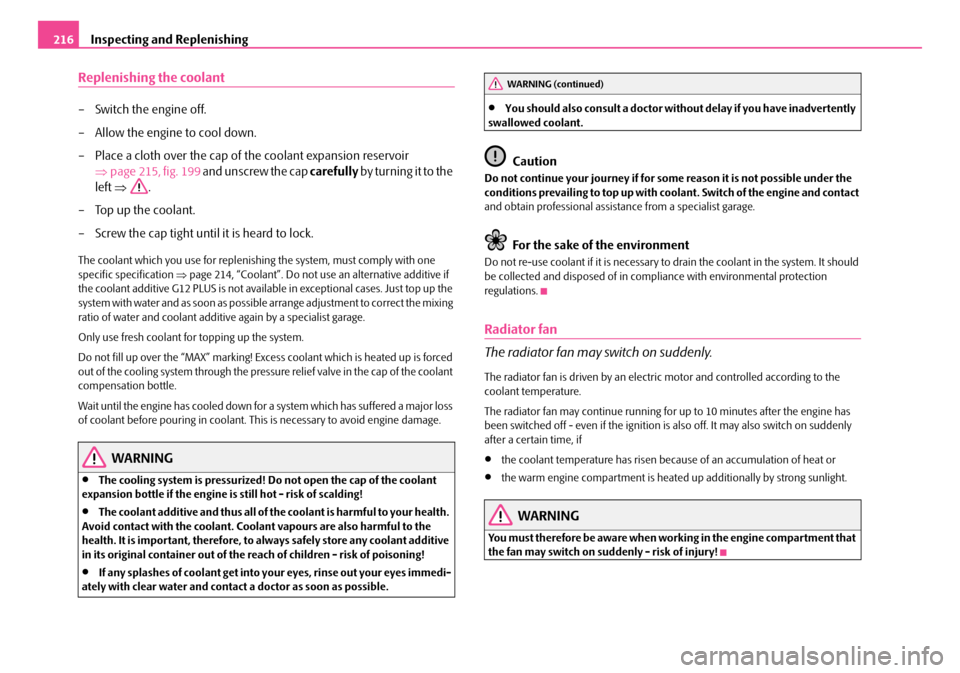
Inspecting and Replenishing
216
Replenishing the coolant
– Switch the engine off.
– Allow the engine to cool down.
– Place a cloth over the cap of the coolant expansion reservoir
⇒page 215, fig. 199 and unscrew the cap carefully by turning it to the
left ⇒ .
– Top up the coolant.
– Screw the cap tight until it is heard to lock.
The coolant which you use for replenishing the system, must comply with one
specific specification ⇒page 214, “Coolant”. Do not use an alternative additive if
the coolant additive G12 PLUS is not availa ble in exceptional cases. Just top up the
system with water and as soon as possible arrange adjustment to correct the mixing
ratio of water and coolant additive again by a specialist garage.
Only use fresh coolant for topping up the system.
Do not fill up over the “MAX” marking! Exce ss coolant which is heated up is forced
out of the cooling system through the pressure relief valve in the cap of the coolant
compensation bottle.
Wait until the engine has cooled down for a system which has suffered a major loss
of coolant before pouring in coolant. Th is is necessary to avoid engine damage.
WARNING
•The cooling system is pressurized! Do not open the cap of the coolant
expansion bottle if the engine is still hot - risk of scalding!
•The coolant additive and thus all of the coolant is harmful to your health.
Avoid contact with the coolant. Coolant vapours are also harmful to the
health. It is important, therefore, to always safely store any coolant additive
in its original container out of the reach of children - risk of poisoning!
•If any splashes of coolant get into yo ur eyes, rinse out your eyes immedi-
ately with clear water and contact a doctor as soon as possible.
•You should also consult a doctor without delay if you have inadvertently
swallowed coolant.
Caution
Do not continue your journey if for some reason it is not possible under the
conditions prevailing to top up with coolant. Switch of the engine and contact
and obtain professional assistance from a specialist garage.
For the sake of the environment
Do not re-use coolant if it is necessary to drain the coolant in the system. It should
be collected and disposed of in comp liance with environmental protection
regulations.
Radiator fan
The radiator fan may switch on suddenly.
The radiator fan is driven by an electric motor and controlled according to the
coolant temperature.
The radiator fan may continue running for up to 10 mi nutes after the engine has
been switched off - even if the ignition is also off. It may also switch on suddenly
after a certain time, if
•the coolant temperature has risen because of an accumulation of heat or
•the warm engine compartment is heated up additionally by strong sunlight.
WARNING
You must therefore be aware when work ing in the engine compartment that
the fan may switch on suddenly - risk of injury!
WARNING (continued)
NKO A5 20 MR08.book Page 216 Wednesday, April 11, 2007 2:54 PM
Page 218 of 288

Inspecting and Replenishing217
Using the systemSafetyDriving TipsGeneral MaintenanceBreakdown assistanceTechnical Data
Brake fluid
Inspecting the brake fluid level
The brake fluid reservoir is located on the left of the engine compartment.
The brake fluid reservoir on right-hand steering models is positioned on
the other side of the engine compartment.
– Switch the engine off.
– Open the bonnet ⇒ in “Working in the engine compartment” on
page 210.
– Inspect the brake fluid level in the reservoir ⇒fig. 200 . The level must
be between the “MIN” and “MAX” markings.
A slight drop in the fluid level results when driving due to normal wear-and-tear
and automatic adjustment of the br ake pads, and is perfectly normal.
There may be an indication of a leak in the brake system, however, if the fluid level
drops significantly within a short time or if it drops below the “MIN” marking. A situ-
ation where the brake fluid level is too low is indicated by the warning light
lighting up in the instrument cluster ⇒page 32. In this case stop the car immedi-
ately and do not drive any further! Co ntact a Škoda Dealer to obtain profes-
sional assistance.
WARNING
•Read and observe the warning notes ⇒page 210, “Working in the engine
compartment” before working in the engine compartment.
•If the fluid level has dropped below the MIN marking, do not drive any
further - risk of accident! Contact a Škoda dealer to obtain professional
assistance.
Replacing brake fluid
Brake fluid absorbs moisture. This causes the fluid to absorb moisture from the
surrounding air over a period of time. Excessive water in the brake fluid may be the
cause of corrosion in the brake system. Th e water content also lowers the boiling
point of the brake fluid. This is why brake fluid must be replaced every two
years.
One may only use new genuine brake fluid from Škoda Auto a.s. The specification
for the brake fluid is “FMVSS 116 DOT 4”.
We recommend that you have the brake fluid replaced by a Škoda Service Partner
as part of an Inspection Service.
WARNING
•Using old brake fluid can result in seve re stress on the brakes because of
the formation of vapour bubbles in th e brake system. This greatly impairs
the braking efficiency and thus al so the safety of your vehicle.
•Brake fluid is toxic! It must therefor e be kept safely in closed original
containers and well away from children and unauthorized persons.
Caution
Brake fluid damages the paintwork of the vehicle.
Fig. 200 Engine
compartment: Brake
fluid reservoir
NKO A5 20 MR08.book Page 217 Wednesday, April 11, 2007 2:54 PM
Page 219 of 288
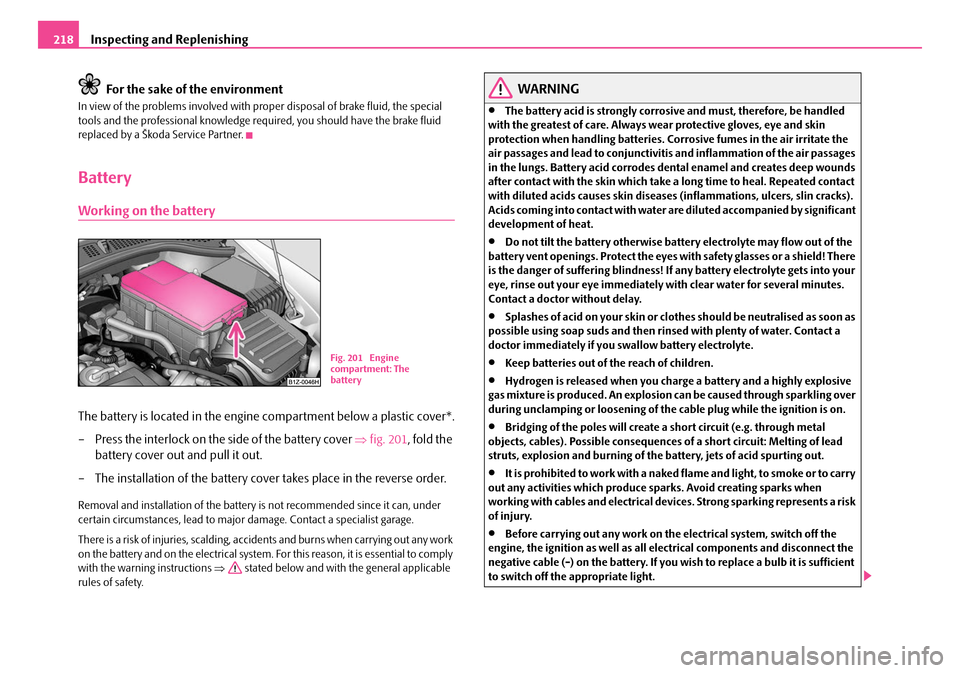
Inspecting and Replenishing
218
For the sake of the environment
In view of the problems involved with prop er disposal of brake fluid, the special
tools and the professional knowledge required, you should have the brake fluid
replaced by a Škoda Service Partner.
Battery
Working on the battery
The battery is located in the engine compartment below a plastic cover*.
– Press the interlock on the side of the battery cover ⇒fig. 201 , fold the
battery cover out and pull it out.
– The installation of the battery co ver takes place in the reverse order.
Removal and installation of the battery is not recommended since it can, under
certain circumstances, le ad to major damage. Contact a specialist garage.
There is a risk of injuries, scalding, acci dents and burns when carrying out any work
on the battery and on the electrical system. For this reason, it is essential to comply
with the warning instructions ⇒ stated below and with the general applicable
rules of safety.
WARNING
•The battery acid is strongly corros ive and must, therefore, be handled
with the greatest of care. Always we ar protective gloves, eye and skin
protection when handling batteries. Corrosive fumes in the air irritate the
air passages and lead to conjunctivitis and inflammation of the air passages
in the lungs. Battery acid corrodes de ntal enamel and creates deep wounds
after contact with the skin which take a long time to heal. Repeated contact
with diluted acids causes skin diseases (inflammations, ulcers, slin cracks).
Acids coming into contact with water are diluted accompanied by significant
development of heat.
•Do not tilt the battery otherwise battery electrolyte may flow out of the
battery vent openings. Protect the eyes with safety glasses or a shield! There
is the danger of suffering blindness! If any battery electrolyte gets into your
eye, rinse out your eye immediately with clear water for several minutes.
Contact a doctor without delay.
•Splashes of acid on your skin or clothes should be neutralised as soon as
possible using soap suds and then rinsed with plenty of water. Contact a
doctor immediately if you swallow battery electrolyte.
•Keep batteries out of the reach of children.
•Hydrogen is released when you char ge a battery and a highly explosive
gas mixture is produced. An explosion can be caused through sparkling over
during unclamping or loosening of the cable plug while the ignition is on.
•Bridging of the poles will create a short circuit (e.g. through metal
objects, cables). Possible consequences of a short circuit: Melting of lead
struts, explosion and burning of the battery, jets of acid spurting out.
•It is prohibited to work with a naked flame and light, to smoke or to carry
out any activities which produce sparks. Avoid creating sparks when
working with cables and electrical device s. Strong sparking represents a risk
of injury.
•Before carrying out any work on the electrical system, switch off the
engine, the ignition as well as all electrical components and disconnect the
negative cable (-) on the battery. If you wish to replace a bulb it is sufficient
to switch off the appropriate light.
Fig. 201 Engine
compartment: The
battery
NKO A5 20 MR08.book Page 218 Wednesday, April 11, 2007 2:54 PM
Page 220 of 288
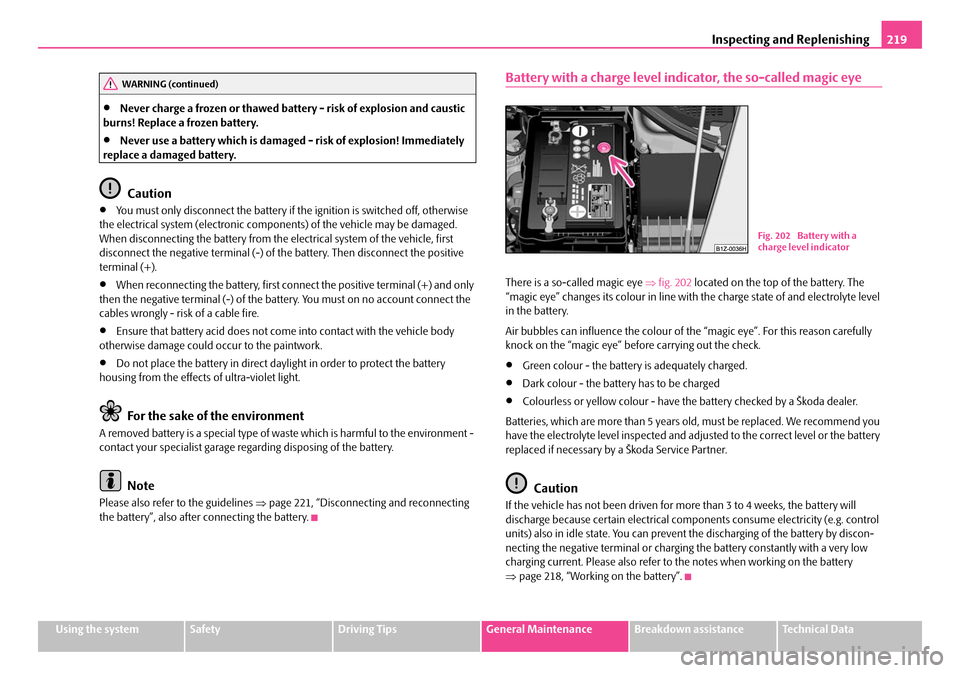
Inspecting and Replenishing219
Using the systemSafetyDriving TipsGeneral MaintenanceBreakdown assistanceTechnical Data
•Never charge a frozen or thawed battery - risk of explosion and caustic
burns! Replace a frozen battery.
•Never use a battery which is damaged - risk of explosion! Immediately
replace a damaged battery.
Caution
•You must only disconnect the battery if the ignition is switched off, otherwise
the electrical system (electronic compon ents) of the vehicle may be damaged.
When disconnecting the battery from the electrical system of the vehicle, first
disconnect the negative terminal (-) of the battery. Then disconnect the positive
terminal (+).
•When reconnecting the battery, first conne ct the positive terminal (+) and only
then the negative terminal (-) of the ba ttery. You must on no account connect the
cables wrongly - risk of a cable fire.
•Ensure that battery acid does not come into contact with the vehicle body
otherwise damage could occur to the paintwork.
•Do not place the battery in direct dayl ight in order to protect the battery
housing from the effects of ultra-violet light.
For the sake of the environment
A removed battery is a special type of waste which is harmful to the environment -
contact your specialist garage regarding disposing of the battery.
Note
Please also refer to the guidelines ⇒page 221, “Disconnecting and reconnecting
the battery”, also after connecting the battery.
Battery with a charge level indicator, the so-called magic eye
There is a so-called magic eye ⇒fig. 202 located on the top of the battery. The
“magic eye” changes its colour in line with the charge state of and electrolyte level
in the battery.
Air bubbles can influence the colour of th e “magic eye”. For this reason carefully
knock on the “magic eye” before carrying out the check.
•Green colour - the battery is adequately charged.
•Dark colour - the battery has to be charged
•Colourless or yellow colour - have th e battery checked by a Škoda dealer.
Batteries, which are more than 5 years old, must be replaced. We recommend you
have the electrolyte level inspected and adju sted to the correct level or the battery
replaced if necessary by a Škoda Service Partner.
Caution
If the vehicle has not been driven for more than 3 to 4 weeks, the battery will
discharge because certain electrical components consume electricity (e.g. control
units) also in idle state. You can prevent the discharging of the battery by discon-
necting the negative terminal or charging the battery constantly with a very low
charging current. Please also refer to the notes when working on the battery
⇒ page 218, “Working on the battery”.
WARNING (continued)
Fig. 202 Battery with a
charge level indicator
NKO A5 20 MR08.book Page 219 Wednesday, April 11, 2007 2:54 PM
Page 235 of 288
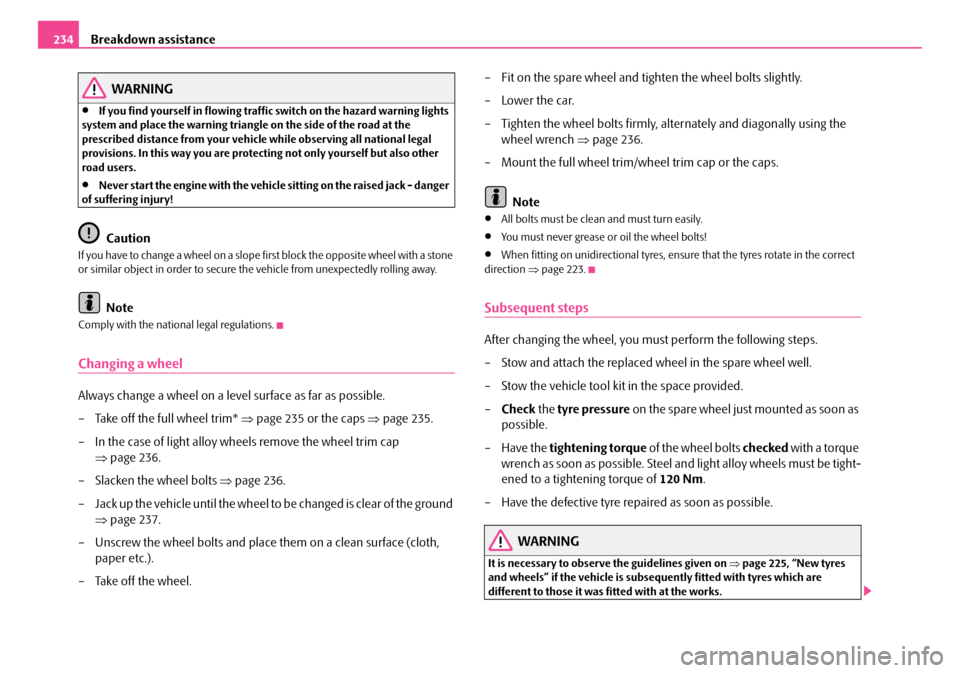
Breakdown assistance
234
WARNING
•If you find yourself in flowing traffic switch on the hazard warning lights
system and place the warning triangle on the side of the road at the
prescribed distance from your vehicl e while observing all national legal
provisions. In this way you are protecting not only yourself but also other
road users.
•Never start the engine with the vehicle sitting on the raised jack - danger
of suffering injury!
Caution
If you have to change a wheel on a slope first block the opposite wheel with a stone
or similar object in order to secure th e vehicle from unexpectedly rolling away.
Note
Comply with the national legal regulations.
Changing a wheel
Always change a wheel on a level surface as far as possible.
– Take off the full wheel trim* ⇒page 235 or the caps ⇒page 235.
– In the case of light alloy wheels remove the wheel trim cap ⇒page 236.
– Slacken the wheel bolts ⇒page 236.
– Jack up the vehicle until the wheel to be changed is clear of the ground
⇒ page 237.
– Unscrew the wheel bolts and place them on a clean surface (cloth, paper etc.).
– Take off the wheel. – Fit on the spare wheel and tighten the wheel bolts slightly.
– Lower the car.
– Tighten the wheel bolts firmly, al
ternately and diagonally using the
wheel wrench ⇒page 236.
– Mount the full wheel trim/w heel trim cap or the caps.
Note
•All bolts must be clean and must turn easily.
•You must never grease or oil the wheel bolts!
•When fitting on unidirectional tyres, ensure that the tyres rotate in the correct
direction ⇒page 223.
Subsequent steps
After changing the wheel, you must perform the following steps.
– Stow and attach the replaced wheel in the spare wheel well.
– Stow the vehicle tool kit in the space provided.
– Check the tyre pressure on the spare wheel just mounted as soon as
possible.
– Have the tightening torque of the wheel bolts checked with a torque
wrench as soon as possible. Steel and light alloy wheels must be tight-
ened to a tightening torque of 120 Nm.
– Have the defective tyre repaired as soon as possible.
WARNING
It is necessary to observe the guidelines given on ⇒page 225, “New tyres
and wheels” if the vehicle is subseq uently fitted with tyres which are
different to those it was fitted with at the works.
NKO A5 20 MR08.book Page 234 Wednesday, April 11, 2007 2:54 PM
Page 239 of 288
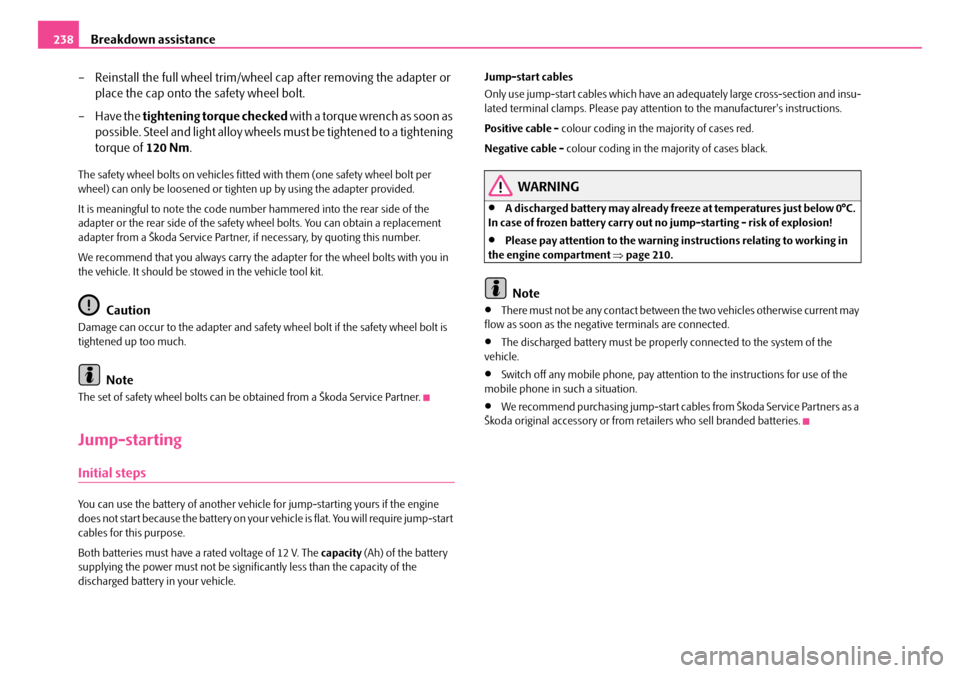
Breakdown assistance
238
– Reinstall the full wheel trim/wheel cap after removing the adapter or place the cap onto the safety wheel bolt.
– Have the tightening torque checked w i t h a t o rq u e w re n c h a s s o o n a s
possible. Steel and light alloy wheels must be tightened to a tightening
torque of 120 Nm.
The safety wheel bolts on vehicles fitted with them (one safety wheel bolt per
wheel) can only be loosened or tigh ten up by using the adapter provided.
It is meaningful to note the code numbe r hammered into the rear side of the
adapter or the rear side of the safety wheel bolts. You can obtain a replacement
adapter from a Škoda Service Partner, if necessary, by quoting this number.
We recommend that you always carry the adapter for the wheel bolts with you in
the vehicle. It should be st owed in the vehicle tool kit.
Caution
Damage can occur to the adapter and safety wheel bolt if the safety wheel bolt is
tightened up too much.
Note
The set of safety wheel bolts can be obtained from a Škoda Service Partner.
Jump-starting
Initial steps
You can use the battery of another vehicl e for jump-starting yours if the engine
does not start because the battery on your vehicle is flat. You will require jump-start
cables for this purpose.
Both batteries must have a rated voltage of 12 V. The capacity (Ah) of the battery
supplying the power must not be significa ntly less than the capacity of the
discharged battery in your vehicle. Jump-start cables
Only use jump-start cables which have an
adequately large cross-section and insu-
lated terminal clamps. Please pay attent ion to the manufacturer's instructions.
Positive cable - colour coding in the majority of cases red.
Negative cable - colour coding in the majority of cases black.
WARNING
•A discharged battery may already freeze at temperatures just below 0°C.
In case of frozen battery carry out no jump-starting - risk of explosion!
•Please pay attention to the warning instructions relating to working in
the engine compartment ⇒page 210.
Note
•There must not be any contact between the two vehicles otherwise current may
flow as soon as the negative terminals are connected.
•The discharged battery must be properly connected to the system of the
vehicle.
•Switch off any mobile phone, pay attent ion to the instructions for use of the
mobile phone in such a situation.
•We recommend purchasing jump-start cabl es from Škoda Service Partners as a
Škoda original accessory or from retailers who sell branded batteries.
NKO A5 20 MR08.book Page 238 Wednesday, April 11, 2007 2:54 PM
Page 241 of 288

Breakdown assistance
240
– Release the clutch particularly gent ly when starting off or depress the
accelerator particularly gently if yo ur vehicle is fitted with an auto-
matic gearbox.
Driver of the towed vehicle
– Switch the ignition on so that the steering wheel is not blocked and you can also operate the turn signal lights, the headlight flasher, the
windscreen wipers and wi ndscreen washer system.
– Take the vehicle out of gear or move the selector lever into position N
if your vehicle is fitted with an automatic gearbox.
– Note that the brake servo unit and power steering only operate if the engine is running. You will require si gnificantly greater physical force
to depress the brake pedal and to steer the vehicle if the engine is not
running.
– Ensure that the tow rope is always kept taught.
Tow rope or tow bar
A tow bar is safest way of towing a vehicle and also minimizes any shocks. You can
use a tow rope only if a suitable tow bar is not available.
The tow rope must be elastic to protect the vehicle. Thus one should only use
plastic fibre rope or a rope made out of a similarly elastic material.
Only attach the tow rope to the towing eyes provided for this purpose ⇒page 241,
“Front towing eye” and ⇒page 241, “Rear towing eye”.
Driving style
Towing another vehicle requires a certain amount of practice. Both drivers should
be familiar with the particular points about towing a vehicle. Unskilled drivers
should not attempt to tow in another vehicle or to be towed in.
One should be constantly vigilant not to allow impermissibly high towing forces or
jerky loadings. There is always a risk of excessive stresses and damage resulting at
the points to which you attach the tow ro pe or tow bar when you attempt to tow a
vehicle which is not standing on a paved road.
Caution
If the gearbox of your vehicle no longer contains any oil because of a defect, your
vehicle must only be towed in with the driven wheels raised clear of the ground, or
on a special vehicle transporter or trailer.
Note
•Please comply with any legal requirements particularly regarding the switched
on signal systems, when towing in or tow-starting another vehicle.
•The tow rope must not be twisted as it may in certain circumstances result in the
front towing eye being unscrewed out of your vehicle.
NKO A5 20 MR08.book Page 240 Wednesday, April 11, 2007 2:54 PM
Page 244 of 288
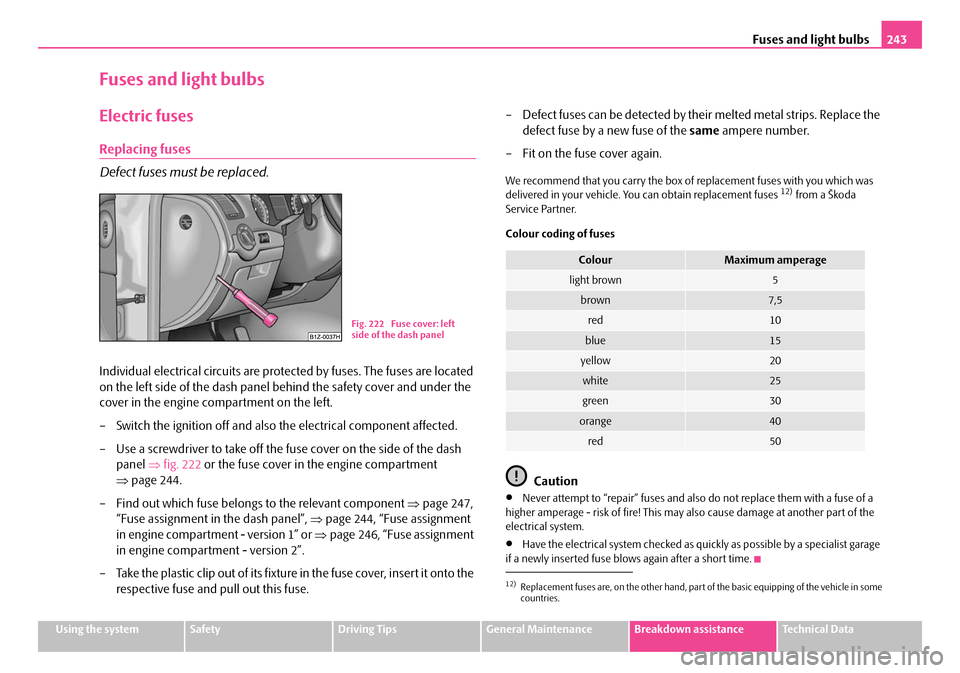
Fuses and light bulbs243
Using the systemSafetyDriving TipsGeneral MaintenanceBreakdown assistanceTechnical Data
Fuses and light bulbs
Electric fuses
Replacing fuses
Defect fuses must be replaced.
Individual electrical circuits are protected by fuses. The fuses are located
on the left side of the dash panel behind the safety cover and under the
cover in the engine compartment on the left.
– Switch the ignition off and also the electrical component affected.
– Use a screwdriver to take off the fuse cover on the side of the dash panel ⇒fig. 222 or the fuse cover in the engine compartment
⇒ page 244.
– Find out which fuse belongs to the relevant component ⇒page 247,
“Fuse assignment in the dash panel”, ⇒page 244, “Fuse assignment
in engine compartment - version 1” or ⇒page 246, “Fuse assignment
in engine compartment - version 2”.
– Take the plastic clip out of its fixture in the fuse cover, insert it onto the respective fuse and pull out this fuse. – Defect fuses can be detected by their melted metal strips. Replace the
defect fuse by a new fuse of the same ampere number.
– Fit on the fuse cover again.
We recommend that you carry the box of replacement fuses with you which was
delivered in your vehicle. You can obtain replacement fuses 12) from a Škoda
Service Partner.
Colour coding of fuses
Caution
•Never attempt to “repair” fuses and also do not replace them with a fuse of a
higher amperage - risk of fire! This may also cause damage at another part of the
electrical system.
•Have the electrical system checked as quickly as possible by a specialist garage
if a newly inserted fuse blows again after a short time.
Fig. 222 Fuse cover: left
side of the dash panel
12)Replacement fuses are, on the other hand, part of the basic equipping of the vehicle in some
countries.
ColourMaximum amperage
light brown5
brown7,5
red10
blue15
yellow20
white25
green30
orange40
red50
NKO A5 20 MR08.book Page 243 Wednesday, April 11, 2007 2:54 PM
Page 246 of 288

Fuses and light bulbs245
Using the systemSafetyDriving TipsGeneral MaintenanceBreakdown assistanceTechnical Data
F11Lambda probe upstream of catalytic converter,
engine control unit10
F12Lambda probe downstream of catalytic converter10
F13Control unit for automatic gearbox15
F14Not assigned
F15Coolant pump10
F16Windshield wiper lever and turn signal light lever5
F17Instrument cluster5
F18Audio amplifier (sound system)30
F19Radio15
F20Phone5
F21Not assigned
F22Not assigned
F23Engine control unit10
F24Control unit for CAN databus5
F25Not assigned
F26Not assigned
F27Not assigned
F28Engine control unit25
F29Actuation for coolant pump after-running5
F30Control unit for auxiliary heating20
F31Front window wiper30
F32Not assigned
F33Not assigned
F34Not assigned
No.Power consumerAmperes
F35Not assigned
F36Not assigned
F37Not assigned
F38Radiator fan, valves10
F39Clutch pedal switch, brake pedal switch5
F40Ignition coils20
F41Not assigned
F42Actuation of fuel pump5
F43Not assigned
F44Not assigned
F45Not assigned
F46Not assigned
F47Central control unit, Left main headlights30
F48Central control unit, Right main headlights30
F49Power supply for terminal 15 (ignition on)40
F50Not assigned
F51Not assigned
F52Power supply relay - terminal X a)40
F53Accessory equipment50
F54Not assigned
a)In order not to drain the battery unnecessarily when starting the engine, the electrical
components of this terminal are automatically switched off.
No.Power consumerAmperes
NKO A5 20 MR08.book Page 245 Wednesday, April 11, 2007 2:54 PM
Page 247 of 288

Fuses and light bulbs
246
Fuse assignment in engine compartment - version 2
Certain electrical components are only st andard on certain vehicle model versions
or only suppliable as optional equipment for certain models.
No.Power consumerAmperes
F1Not assigned
F2Windshield wiper lever and turn signal light lever5
F3Measuring circuit5
F4Valves for ABS30
F5Control unit for automatic gearbox15
F6Instrument cluster5
F7Not assigned
F8Radio15
F9Phone5
F10Engine control unit, Main relay5
F11Control unit for auxiliary heating20
Fig. 225 Schematic
representation of fuse
box in engine compart-
ment - version 2
F12Control unit for CAN databus5
F13Engine control unit15
F14Ignition20
F15Lambda probe, NOx-sensor, Fuel pump relay
Glow plug system relay15 5
F16Pump for ABS30
F17Horn15
F18Amplifier for digital sound processor30
F19Front window wiper30
F20Not assigned5
F21Lambda probe15
F22Clutch pedal switch, brake pedal switch5
F23Secondary air pump
Air mass meter
Fuel high pressure pump5
10
15
F24Activated charcoal filter, exhaust gas recirculation
valve10
F25Right lighting system30
F26Left lighting system30
F27Secondary air pump
Preglowing40
50
F28Power suppy terminal 15, Starter40
F29Power supply terminal 3050
F30Te r m i n a l Xa)40
a)In order not to drain the battery unnecessarily when starting the engine, the electrical
components of this terminal are automatically switched off.
No.Power consumerAmperes
NKO A5 20 MR08.book Page 246 Wednesday, April 11, 2007 2:54 PM